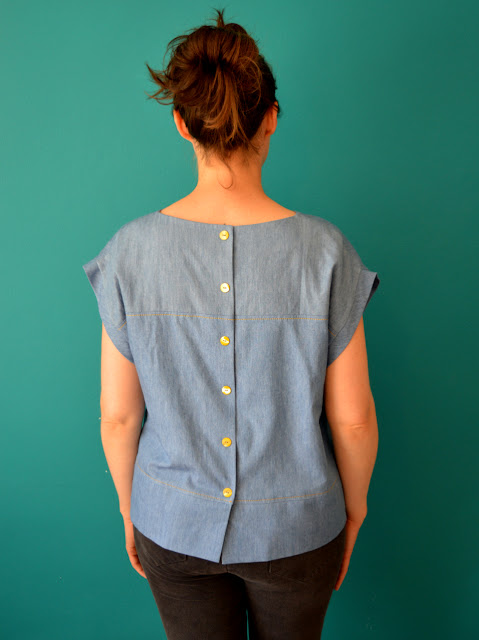Despite being a very active and fearless little girl, my daughter likes to wear dresses or skirts whenever it's an option, and the girlier the better. Ever since I compiled the blog posts listing heaps of independent children's pattern companies, I've been keeping an eye on the output of Elegance & Elephants. I think most of the patterns hit the sweet spot between 'classic' and 'modern', with a decent dose of 'girly' if that's what you're looking for. Until recently, the free Retro Sweatpants pattern was the only one of theirs that I'd actually made, then they released the Pauline dress/tunic pattern. You know me, I've got a weakness for ruffles, plus I felt confident that it was generally a style that Dolores could also get behind. So when the pattern's release was shortly followed by a handily timed sale, I splashed the paypal-cash quicker than you can blink.
Pattern:
The Pauline dress is an A-line shaped garment with a nicely-proportioned, rounded yoke and ruffle detail. There is some gathering at the centre front and centre back where the lower sections are joined to the yoke. This gathering adds a bit more fullness and volume, making this woven garment very easy to wear and move around in. Most of the versions pictured on the site, including the pattern testers' versions, are sleeveless, but there is also a sleeve pattern piece included for long or three-quarter sleeves.
Dolores is presently a couple of months away from her fifth birthday, so I made the size 5 but the size 6 length. I'm pleased to report that it fits her well at the moment, but should see her through next summer as well.
(image source: Elegance & Elephants)
In general, the construction was fun and the steps were explained well, with clear photos for each. However, there were two bits that I didn't love that I would probably change for future versions. The first concerns the back neck fastening. I was surprised to find that the back yoke and facing are cut on the fold. A small piece of elastic forms a button loop, and ends up being inserted at the edge of the key hole/slit. To be honest, I couldn't really visualise how it was going to work, but I bumbled along ok. The key hole/slit is created by stitching a very tight V shape that you then are meant to snip into and turn the whole through with the right side facing out. I found the instructions for how not to get the elastic caught up in the V stitching were a bit lacking. As for the V shaped stitching and turning through, I have no idea how the samples on their website look so neat, because I definitely couldn't! I ended up stitching a narrow rectangle that could be snipped into more easily, and the result looks pretty good.
The second part I didn't like was related to the facing. The instructions for the sleeveless version have you stitching the facing to the armhole by encasing the whole top part of the garment and turning though. It's not a method I have used before, and the instructions includes a handy link to a more detailed Youtube video tutorial (which you can see here). Here's the rub: once complete, I found the facing ended up too large and peeped out through the neck hole. I fixed the issue later by stitching-in-the-ditch through the ruffle seam. I'm not blaming the method used for attaching the facing, and in fact it was fun to try something new, however I think trying this less-known-to-me method meant I wasn't able to spot a potential problem until it was too late. It's possible that the facing wouldn't be too large or peek out if I simply pressed rather than understitched-then-pressed the neckline, which creates a neat neck hole but essentially pushes the facing further inside. In the future, I would trim the facing away at the armholes by about .75cm before applying it to the outer garment.
Fabric:
Let it be known, this is NOT the fabric I would have chosen if I had given myself free rein. However, Dolores has made it clear a number of times how much she likes this ditsy floral cotton lawn, which has been lurking in my stash for about six years. It's the same fabric I used to line these bubble shorts and there's still over 1m left, so you'll probably see it again at some point. It's a kind of faux-Liberty print and is really nice to work with, and most likely very pleasant to wear in the heat wave we've been having of late.
I have found in the past that details, particularly gathering, can get really lost in a small, dense print like this. Therefore, I picked some contrast white fabric that was residing in my scraps tub for the ruffle instead.
Although I wouldn't have chosen this fabric, it is undeniably pretty and I think she looks lovely in this dress. It's been a winner so far and she wore it a couple of times on our recently holiday to France. I'm excited to make more versions of this pattern; next up will hopefully be an autumn blouse using the tunic length with long sleeves. I'll definitely be trimming the facing piece down a touch. The lawn worked really well, but I'd like to try it in lighter and slightly heavier (but drapey) weight fabrics. What type of fabric would you try making this dress in?































